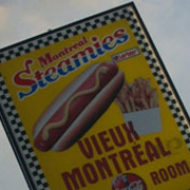Today was a big medical day. I stayed home from the Center so that Ya-Ya could get his eye pressure checked (glaucoma) and I could talk with a local endocrinologist about my fatigue. We went over my blood results and determined that my TSH could be further suppressed (which means increasing my dose of synthroid) and that it might make me feel better. I’m not anemic and I don’t have a hangover from radiation fatigue (two alternate theories that were dismissed), so that’s a relief.
Of course what is more blogworthy is my visit to a non-profit medical center for this task. They may still be nonprofit but money suffuses all the interactions. My Quebec insurance requires that I put out the cash and then ask for reimbursement (and when I don’t get the full reimbursement, I go to my private insurance–this will take months as you can see). When I arrived at the endocrinology department, I got an intake form which I expected to be the usual case history thing. Nope — there was room for 3 insurers, and then a spouse and someone not living with me they could contact in “an emergency” (like if I didn’t pay my bill). After filling that out, I sat down in the waiting room. I was called back up to sign another form regarding a discount for prompt payment (it said 25%, I was told 30 on the phone, which they gave me when I asked). Then I saw the doctor and we talked. Though I am happy to go through whatever is necessary to feel better, I did feel the need to ask for no unnecessary tests since each one would mean more money out of pocket for me. He did a careful physical exam and asked me lots of questions which showed that he was thoughtful and thorough, and then we went over where my bloods ought to be vs. where they are. My TSH is at .68, which is in the “normal” range but the American Thyroid Association guidelines suggest that it should be lower for high risk patients and anecdotal evidence from other thyroid cancer patients suggests that .68 is a bit high to feel fully good. There is a balancing act between TSH, which you want low and T3 and T4, which you don’t want too high. Synthroid does suppresses the TSH and elevates the T3 and T4, so past a certain point it’s not good to increase my dose. Nevertheless we’re giving it a shot and that will be that.
After the visit, I paid — it was about $300 before the discount and I suspect they were being nice. Then I went down to billing to see if I could pay for the blood test I had just under two weeks ago. The results are in the system but not the bill. The billing office is not a happy place. I saw the two people ahead of me come out of there with long, serious faces and I could tell from the tone of one of the conversations that the topic was unpaid bills that needed to be cleared up for further service.
I left the building marvelling at how lucky I am to be able to afford my healthcare.
Oh yeah, the synthroid was $20 for a months’ supply, about twice which I pay in Quebec. Though I didn’t shop around — I got it while picking up a few groceries.
Oh yes: Ya-Ya’s glaucoma? It’s stable. His vision isn’t great, though and I suspect it’s gotten a bit worse. He’s spent the day in his “safe place” (ie, the carrier) since returning home. The vet bills are higher here as well.
—
As to today’s report in the NYTimes that a judge ruled part of Obama’s healthcare plan unconstitutional, all I can say is “meh.” It is kind of stupid to mandate that people buy insurance, instead of simply specifying medical care as a right.
